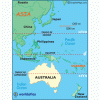Climate & Environment
- <p>A new study led by the University of Colorado Boulder found that different strategies used by states to reduce power plant emissions -- direct ones such as emission caps and indirect ones like encouraging renewable energy -- are both effective. The study is the first analysis of its kind.</p>
 <p>The gradual fall cooling on Colorado’s Front Range this September is helping to set up what could well be a prime-time show of gold, yellow and red leaves in the region’s aspen forests, according to a University of Colorado Boulder plant ecologist.</p>
<p>The gradual fall cooling on Colorado’s Front Range this September is helping to set up what could well be a prime-time show of gold, yellow and red leaves in the region’s aspen forests, according to a University of Colorado Boulder plant ecologist.</p> <p>A NASA mission to Mars led by the University of Colorado Boulder is set to slide into orbit around the red planet Sept. 21 to investigate how its climate has changed over the eons, completing a 10-month interplanetary journey of 442 million miles.</p>
<p>A NASA mission to Mars led by the University of Colorado Boulder is set to slide into orbit around the red planet Sept. 21 to investigate how its climate has changed over the eons, completing a 10-month interplanetary journey of 442 million miles.</p>
<p>The orbit-insertion maneuver will begin with six thruster engines firing to shed some of the velocity from the spacecraft, known as the Mars Atmosphere and Volatile EvolutioN, or MAVEN mission. The thruster engines will ignite and burn for 33 minutes to slow the spacecraft, allowing it to be captured into an elliptical orbit around Mars.</p> <p>Three of the 62 scientists from around the world elected this week as American Geophysical Union Fellows are from the University of Colorado Boulder, tying the university for the most fellows elected in 2014 with the Woods Hole Oceanographic Institution in Massachusetts and Oregon State University in Corvallis.</p>
<p>Three of the 62 scientists from around the world elected this week as American Geophysical Union Fellows are from the University of Colorado Boulder, tying the university for the most fellows elected in 2014 with the Woods Hole Oceanographic Institution in Massachusetts and Oregon State University in Corvallis.</p>
<div>
The CU-Boulder honorees include Professor Anne Sheehan of the Department of Geological Sciences, Professor Shijie Zhong of the Department of Physics and Senior Research Associate Tom Woods of the Laboratory for Atmospheric and Space Physics. </div> <p>A new study led by Old Dominion University and the University of Colorado Boulder indicates sea levels likely will continue to rise in the tropical Pacific Ocean off the coasts of the Philippines and northeastern Australia as humans continue to alter the climate.</p>
<p>A new study led by Old Dominion University and the University of Colorado Boulder indicates sea levels likely will continue to rise in the tropical Pacific Ocean off the coasts of the Philippines and northeastern Australia as humans continue to alter the climate.</p> <p>Meet perhaps the tiniest hedgehog species ever: <em>Silvacola acares. </em>Its roughly 52-million-year-old fossil remains were recently identified by a University of Colorado Boulder-led team working in British Columbia.</p>
<p>Meet perhaps the tiniest hedgehog species ever: <em>Silvacola acares. </em>Its roughly 52-million-year-old fossil remains were recently identified by a University of Colorado Boulder-led team working in British Columbia.</p>
<p><span id="">The hedgehog’s scientific name means “tiny forest dweller,” said CU-Boulder Associate Professor Jaelyn Eberle of the geological sciences department, lead author on the study. The creature -- a new genus and species to science -- was only about 2 inches long, roughly the length of an adult thumb.</span></p>- <p class="p1">The massive increase in earthquakes in central Oklahoma is likely being caused by the injection of vast amounts of wastewater from oil and gas operations into underground layers of rock, according to a new study led by Cornell University and involving the University of Colorado Boulder.</p>
 <p>The United States has been selected as one of five international hubs for Future Earth, an ambitious 10-year research initiative to address global environmental change solutions and actions. The U.S. hub will be headquartered in Colorado and managed jointly by Colorado State University and the University of Colorado Boulder.</p>
<p>The United States has been selected as one of five international hubs for Future Earth, an ambitious 10-year research initiative to address global environmental change solutions and actions. The U.S. hub will be headquartered in Colorado and managed jointly by Colorado State University and the University of Colorado Boulder.</p>- <p>Sharks were a tolerant bunch some 50 million years ago, cruising an Arctic Ocean that contained about the same percentage of freshwater as Louisiana’s Lake Ponchatrain does today, says a new study involving the University of Colorado Boulder and the University of Chicago.</p>
 <p>A $1.5 million grant from the Environmental Protection Agency will help researchers at the University of Colorado Boulder and the National Center for Atmospheric Research measure pollution from residential cooking and better understand a problem that kills millions of women and children each year in the developing world.</p>
<p>A $1.5 million grant from the Environmental Protection Agency will help researchers at the University of Colorado Boulder and the National Center for Atmospheric Research measure pollution from residential cooking and better understand a problem that kills millions of women and children each year in the developing world.</p>


